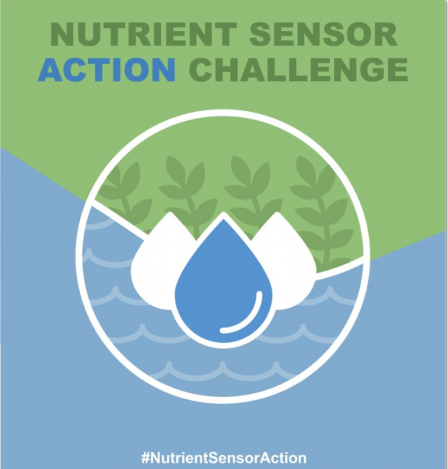Nutrient Sensor Action Challenge Stage I Winners
For more information about the Challenge, go here.
Stage I Winning Projects:
Continuous Nitrate Monitoring on the Galena River: A Basis for Change
High Frequency Nitrogen Sensors in Portland, Maine
Monitoring the Effects of Storms and Conowingo Dam Inputs on Nutrients in the Upper Chesapeake Bay
Quantifying the impact of dam removals on nitrate retention using low cost nitrate sensors
Challenge Overview
The Nutrient Sensors in Action Challenge is a collaboration between the U.S. Environmental Protection Agency, the United States Geological Survey (USGS), the United States Department of Agriculture (USDA), the National Institute of Standards and Technology (NIST) and the National Oceanic and Atmospheric Administration (NOAA)-led U.S. Integrated Ocean Observing System (U.S. IOOS®).
Stage I Winning Projects:
The League of Women Voters of Jo Daviess County in Illinois (LWV-JDC) has been actively seeking water quality data in order to increase local knowledge. The ultimate goal is to achieve science-based stewardship of local water resources. This project proposes that two sensors be deployed, one each at the top and bottom of the Lower Galena River subwatershed to gather continuous data on nitrate levels in this portion of the Galena River. The League has been building relationships throughout the area for over six years and those relationships will provide valuable avenues for communicating the results of the data obtained through continuous nitrate monitoring. These data will be used as a basis for shifting landowners to best management practices designed to reduce nutrient pollution.
Development of a Real-time, Continuous Nutrient Monitoring Network for Western Lake Erie to Address Management of HABs and Hypoxia
Team Lead: Thomas Johengen, Cooperative Institute for Great Lakes Research (CIGLR), University of Michigan
Since the 1990s, Lake Erie has been experiencing increased water quality impairment, primarily in the form of extensive toxic cyanobacterial blooms. To combat the growing impacts on the ecosystem health and services of these tremendous natural resources, the Governments of Canada and the United States developed revised binational phosphorus reduction targets for Lake Erie with a goal of 40% lower loading rates then established under the 2012 Great Lakes Water Quality Agreement (GLWQA). To determine progress toward meeting nutrient reduction targets and verifying the response in the lake, active surveillance of nutrients in the lake is essential. Phosphorus concentrations in Lake Erie are highly variable in time and space, making it difficult to determine long-term trends. Deployment of continuous monitoring sensors to provide nearly continuous data will be a critical component of successful nutrient management.
Monitoring the Effects of Storms and Conowingo Dam Inputs on Nutrients in the Upper Chesapeake Bay
Lora Harris (Team Lead) & Jeremy Testa, University of Maryland Center for Environmental Science
Mike Trice, Maryland Department of Natural Resources
The Chesapeake Bay estuary has a long history of degraded water quality associated with elevated inputs of nitrogen (N), phosphorus (P), and sediments from its large watershed that spans six states and the District of Columbia. The Conowingo Dam, which is located in the lower Susquehanna River - the Bay's largest source of nutrients and freshwater - is decreasingly effective at holding back silt from entering the Upper Chesapeake Bay. As a result, additional nutrients associated with those silts are entering Chesapeake Bay and nutrient and sediment reduction strategies are being developed to address the increased nutrient load. The impact of these "new" nutrient inputs to Chesapeake Bay, however, remains poorly understood. This project would place two sensors in the Upper Chesapeake Bay and provide much data on how the nutrient load changes over time and in response to storm events. This can help validate models and give insight into the effect these nutrients will have on phytoplankton production and associated oxygen depletion in the estuary.
Quantifying the impact of dam removals on nitrate retention using low cost nitrate sensors
Team Lead: Dr.Wilfred Wollheim, Department of Natural Resources and Environment, University of New Hampshire
Current understanding of how reservoirs affect nitrogen moving through river systems is based on a small number of studies in larger reservoirs. These studies also looked at annual estimates rather than evaluating how nutrient retention varied through time. Dams and their reservoirs are increasingly being removed from the landscape, often because they are aging and would need costly repairs, have no significant utility and/or to improve anadromous fish passage and connectivity with spawning areas. Because reservoirs created by dams are potentially effective at removing nitrogen, such dam removals come with tradeoffs, including reduced nitrate removal. We propose to deploy sensors upstream and downstream of several reservoirs in coastal New England to quantify nitrate removal across seasons and storm events. We will also take advantage of ongoing dam removals and management activities to quantify the nitrogen removal by reservoirs.
Other Nutrient Challenges
The Nutrient Sensors in Action Challenge is part of a suite of Challenges that aim to take a collaborative, data-driven approach to addressing nutrient pollution. The first, the Nutrient Sensor Challenge sought the development of an affordable, reliable sensor for measuring nitrate and phosphate levels in water. The Visualizing Nutrients Challenge tasked participants with using open government data sources to create compelling, innovative, and comprehensible visualizations of the complexities of nutrient pollution. High School students participated in the Visualize your Water Challenge that was a collaboration with USGS. The Advanced Septic Nitrogen Sensor Challenge is also underway seeking to identify and spur development of technologies to monitor nitrogen concentration in effluent from wastewater treatment systems. With the Nutrient Sensor Action Challenge we can demonstrate successful strategies for incorporating nutrient sensors into existing water monitoring efforts, and help states and communities overcome the major barriers to taking action to prevent and reduce nutrient pollution.
